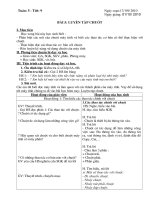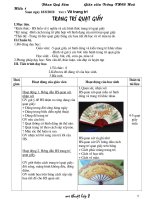AN EXERCISE ABOUT DISCOURSE ANALYSIS(DINH DUC NHAT)
Bạn đang xem bản rút gọn của tài liệu. Xem và tải ngay bản đầy đủ của tài liệu tại đây (142.69 KB, 8 trang )
University of Languages and International study
Vietnam National University, Hanoi
DISCOURSE ANALYSIS
Assignment
Supervisor:
Student’s full name: Dinh Duc Nhat
Group: 06.1E4
Hanoi, April 2010
University of Languages and International study
Vietnam National University, Hanoi
Student’s full name: Dinh Duc Nhat
Group: 06.1E4
DISCOURSE ANALYSIS
Assignment
-Find an example of narrative discourse.
-Define the topic framework and relevant factors in the text.
-Analyze the text in terms of its generic stages. Draw the diagram and work
at that.
Table of content
I- An example of narrative discourse
II- The topic framework and relevant factors in the text.
III- The diagram and the analysis of the text in terms of its generic
stages.
IV- Reference
The process of working
I-An example of narrative discourse.
A Shepherd Boy tended his master's sheep near a dark forest not
far from the village. Soon he found life in the pasture very dull. All
he could do to amuse himself was to talk to his dog or play on his
shepherd's pipe.
One day as he sat watching the sheep and the quiet forest, and
thinking what he would do should he see a wolf, he thought of a plan
to amuse himself.
His master had told him to call for help should a wolf attack the
flock, and the villagers would drive it away. So now, though he had
not seen anything that even looked like a wolf, he ran toward the
village shouting at the top of his voice, "Wolf! Wolf!"
As he expected, the villagers who heard the cry dropped their work
and ran in great excitement to the pasture. But when they got there
they found the boy doubled up with laughter at the trick he had
played on them.
A few days later the Shepherd Boy again shouted, "Wolf! Wolf!"
Again the villagers ran to help him, only to be laughed at again.
Then one evening as the sun was setting behind the forest and the
shadows were creeping out over the pasture, a Wolf really did
spring from the underbrush and fall upon the Sheep.
In terror the boy ran toward the village shouting "Wolf! Wolf!" .But
though the villagers heard the cry, they did not run to help him as
they had before. "He cannot fool us again," they said.
The wolf killed a great many of the boy's sheep and then slipped
away into the forest.
Liars are not believed even when they speak the truth.
/>II- The topic framework and relevant factors in the text. Analysis of the
text in term of its generic stages.
In order to have a language map of topic framework and relevant factors
in the text above, we initially must understand what topic framework is. The
notion of topic framework consists of the notion “topic” which is quite
elusive, different scholars use it to refer to different phenomena, from a
constituent of a clause to propositions of a text. According to Nunan (1993:
125), topic is “the subject matter of a text”. It is a means of delimiting a unit
of text/talk; the central orhanizing principle for a lot of discourse. In Keenan
and Schieffeli’s points of view, discourse topic is not simply a noun phrase
or a sentence. It is the proposition, about which the claim is made or elicited.
This approach is close to the understanding of discourse topic as a title of
discourse. In An Introduction to Discourse Analysis by Nguyen Hoa, the
notion “topic” as “ what is being talk about” is attractive because it seems to
be the central organizing principle for a lot of discourse, and it might help us
to determine what set of sentences should be considered together as a set of
some kind, separate from another set. This can serve as a criterion for
distinguishing the connected coherent from anything that is not. However,
what is needed is a characterization of “topic”, and as Brown and Yule
suggest, this is possible with in a topic “framework”.
A topic framework should comprise all the activated (relevant to the
interpretation of what is said or written) features of context because they are
the aspects of contexts directly reflected in the text, and need to be called
upon to interpret it. What happens is that the speaker or writer usually
operate within this topic framework to produce language, thus we will have
a sense that the sentences are connected topically.
According to Brown and Yule, as there are a large number of phrases
expressing the topic of even a short text, a topic framework was introduced.
A topic framework depends on which features of context became activated
in a particular piece of discourse.
In general, the topic framework would represent a combination of
elements derived from the activated physical context (time and place, facts
about the speaker and the hearer), and from the discourse fragment itself
(people, places, entities, events, facts, etc.) often previously mentioned in the
discourse.
As can be seen in the model of narrative discourse above, in the text, the
topic framework is the story of a shepherd boy who was a liar and the
massage to the readers “
Liars are not believed even when they speak
the truth”
. This boy told the villagers a lie that wolf appeared to kill his
flock of sheep. His lie was repeated the second time. And the third time,
when the appearance of the wolf was the truth, the villagers did not come to
help him any more because they thought that was a more lie of the boy.
Through the story, all of the events, characters, time and sentences are
combined to aim at describing the story about the lie of the shepherd boy
and its consequence as the topic framework in the text.
Similarly, to define the relevant factors in the text, we must firstly have
knowledge of what relevance is. In An Introduction to Discourse Analysis
by Nguyen Hoa, relevance is an important indicator of the topic framework,
at least from English point of view. We will all feel whether a piece of
information is relevant or not. We think by relevance, we mean that a piece
of information should be relevant to the existing topic framework, since it is
the central organizing axis of discourse.
Thus it is possible to modify Grice’s Relation Maxim: participants of the
conversation have to make their contributions relevant in terms of the
existing topic framework. They are expected to be speaking topically as
Brown and Yule suggest the use of expression “speaking topically” instead.
That is: A discourse participant is “speaking totally” when he make his
contribution fit closely to the most recent elements incorporated in the topic
framework”, (Brown and Yule, 1983:84).
All things considered, the relevant factors shown in the text are all the
characters consisting of shepherd boy, villagers, wolf, flock of sheep; the
place where the boy tended his master’s ship; the events that the boy told lie
twice and when the wolf appeared to kill his sheep in the third time he cried
out “wolf, wolf!” All this factors are relevant to one another and combined
in the topic framework of the text, Liars are not believed even when they
speak the truth.
III- The diagram and analysis of the text in terms of its generis stages:
Thanks to the diagram drawn below, it is easily visualised in Hoey's pionts
of view that the full problem solution pattern consists of five elements.
To begin with, it is the situation within which there is a complication or
problem. The situation occurs in sentences 1,2,3,4 and 5. In this part, the
setting of the story is built with the place, and characters, scene…and the
reason making the boys fell bored and dull. This makes the readers have a
prediction about the behaviors of the shepherd boy.
In the construction of the text’s generic stages, the next stage is the creation
of problem for the story. Then series of problems are created. The first one is
the first lie of the boy and he receives the first response of the villagers.
They run towards the boy to help him. Continuously, the second problem is
followed by the first problem and it receives the second response of the
villagers, they again revive the trick of the boy. The story is continued to
reach to the climax (highest point) when the next problem happens. This
time a Wolf really did spring from the underbrush and fall upon the Sheep. It is
quite different from the last two responses. The village’s response is not to run
to help the boy.
Afterwards, the result is that the boy was in terror without help from the
villagers.
As a massage to the readers, the evaluation for the whole story is the ending of
the story “
Liars are not believed even when they speak the truth.”
Situation in which problems created:
(sentences 1,2,3,4,5)
Pronlem 1: Response to problem 1
(sentence 6) (sentences 7,8)
Problem 2: Response to problem 2
(sentences 9) (sentence 10)
Problem 3: Response to problem 3
(sentences 11,12) (sentences 13,14)
Result/ solution
(sentence 15)
Evaluation of result
or solution.
(sentence 16)
IV- References:
Brown G., Yule G. Discourse Analysis. (1983)
Hoey, M. 1994. Signalling in Discourse: a functional analysis of a common
discourse pattern in written and spoken English. In Coulthard (1994a). 26-
45.
Nunan, D. Introducing Discourse Analysis. (1993). Penguin Books
Nguyen Hoa. An Inroduction to Discourse Analysis
Schiffrin D. Approaches to Discourse. (1994). Oxford & Cambridge:
Blackwell.
/>









